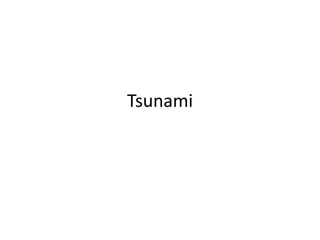Tsunami
•Download as PPTX, PDF•
0 likes•526 views
Tsunamis are series of large ocean waves caused by the displacement of water, often triggered by earthquakes, volcanic eruptions, or landslides under the sea. As they approach land, their speed decreases but their wavelength shrinks and amplitude grows enormously. They can cause damage by massive walls of fast moving water and by draining large volumes of water off the land. While most tsunamis occur in the Pacific Ocean, they can happen anywhere there are large bodies of water.
Report
Share
Report
Share

Recommended
Recommended
More Related Content
What's hot
What's hot (19)
Similar to Tsunami
Similar to Tsunami (20)
Recently uploaded
Recently uploaded (20)
Vector Search -An Introduction in Oracle Database 23ai.pptx

Vector Search -An Introduction in Oracle Database 23ai.pptx
Decarbonising Commercial Real Estate: The Role of Operational Performance

Decarbonising Commercial Real Estate: The Role of Operational Performance
"I see eyes in my soup": How Delivery Hero implemented the safety system for ...

"I see eyes in my soup": How Delivery Hero implemented the safety system for ...
AWS Community Day CPH - Three problems of Terraform

AWS Community Day CPH - Three problems of Terraform
Web Form Automation for Bonterra Impact Management (fka Social Solutions Apri...

Web Form Automation for Bonterra Impact Management (fka Social Solutions Apri...
The Zero-ETL Approach: Enhancing Data Agility and Insight

The Zero-ETL Approach: Enhancing Data Agility and Insight
Repurposing LNG terminals for Hydrogen Ammonia: Feasibility and Cost Saving

Repurposing LNG terminals for Hydrogen Ammonia: Feasibility and Cost Saving
How to Check CNIC Information Online with Pakdata cf

How to Check CNIC Information Online with Pakdata cf
Cloud Frontiers: A Deep Dive into Serverless Spatial Data and FME

Cloud Frontiers: A Deep Dive into Serverless Spatial Data and FME
Design and Development of a Provenance Capture Platform for Data Science

Design and Development of a Provenance Capture Platform for Data Science
ChatGPT and Beyond - Elevating DevOps Productivity

ChatGPT and Beyond - Elevating DevOps Productivity
Cloud Frontiers: A Deep Dive into Serverless Spatial Data and FME

Cloud Frontiers: A Deep Dive into Serverless Spatial Data and FME
Tsunami
- 1. Tsunami
- 2. The term tsunami comes from the Japanese, composed of the two kanji. Tsu meaning “harbor” and nami meaning “wave” Tsunami is a series of water waves caused by the displacement of a large volume of a body of water, generally an ocean or a large lake. Earthquakes, volcanic eruptions and other underwater explosions, above or below water all have the potential to generate a tsunami
- 3. Tsunamis cause damage by two mechanisms: the smashing force of a wall of water travelling at high speed, and the destructive power of a large volume of water draining off the land. A tsunami in the deep ocean has a much larger wavelength of up to 200 kilometers (120 mi). Such a wave travels at well over 800 kilometers per hour (500 mph).
- 4. As the tsunami approaches the coast and the waters become shallow, wave shoaling compresses the wave and its speed decreases below 80 kilometers per hour (50 mph). Its wavelength diminishes to less than 20 kilometers (12 mi) and its amplitude grows enormously. Open bays and coastlines adjacent to very deep water may shape the tsunami further into a step-like wave with a steep-breaking front.
- 5. About 80% of tsunamis occur in the Pacific Ocean, but they are possible wherever there are large bodies of water, including lakes. They are caused by earthquakes, landslides, volcanic explosions, glacier calving, and bolides.
- 6. A tsunami cannot be precisely predicted, even if the magnitude and location of an earthquake is known. Geologists, oceanographers, and seismologists analyze each earthquake and based on many factors may or may not issue a tsunami warning. However, there are some warning signs of an impending tsunami, and automated systems can provide warnings immediately after an earthquake in time to save lives.
